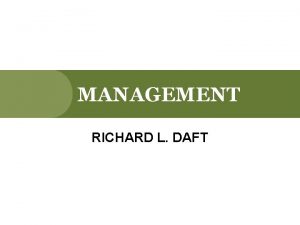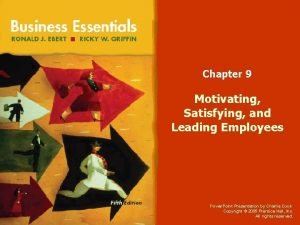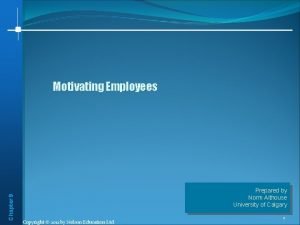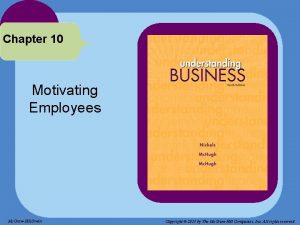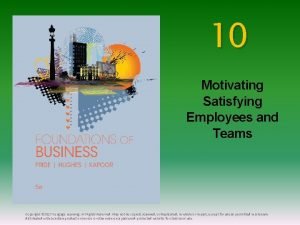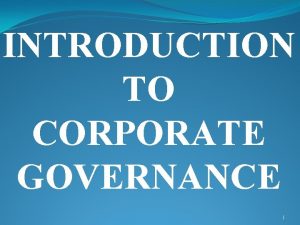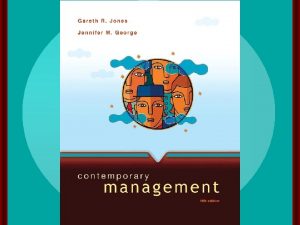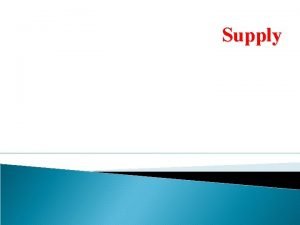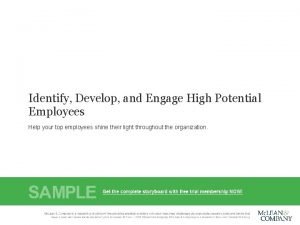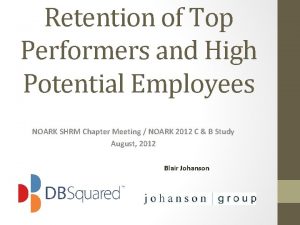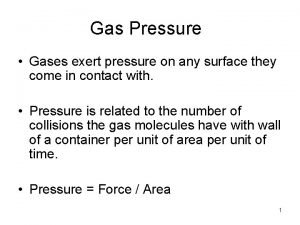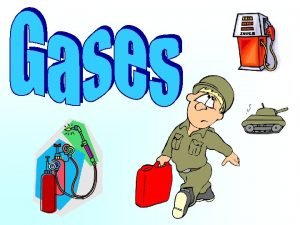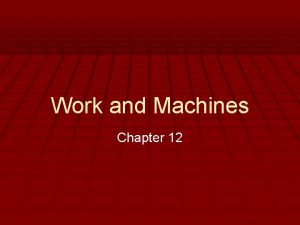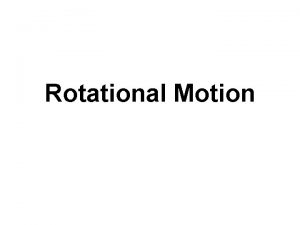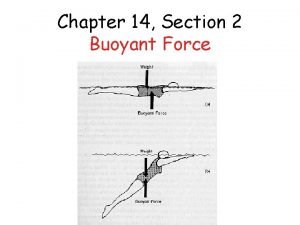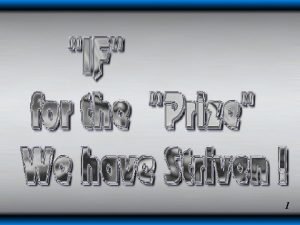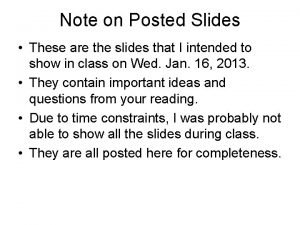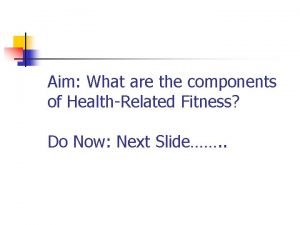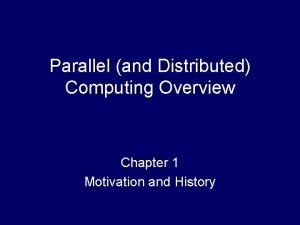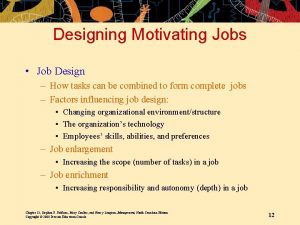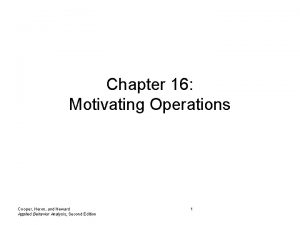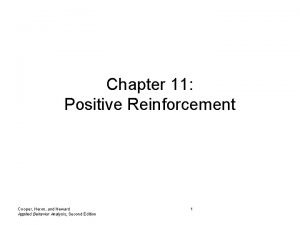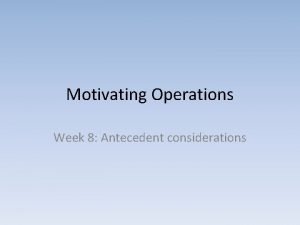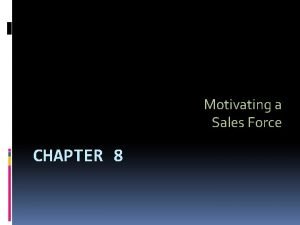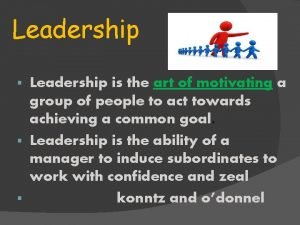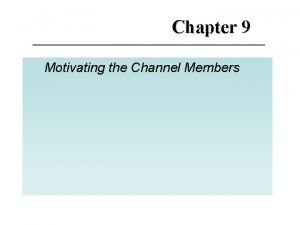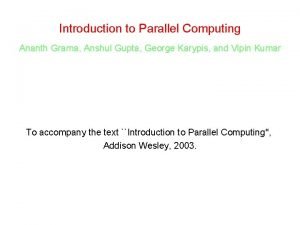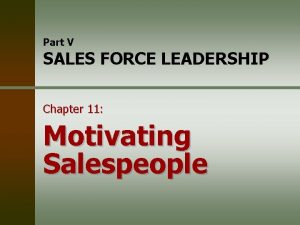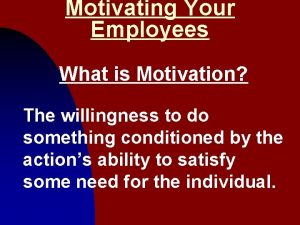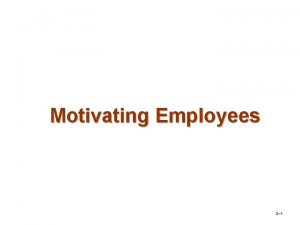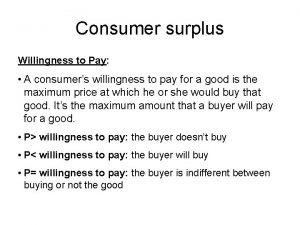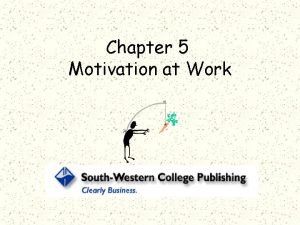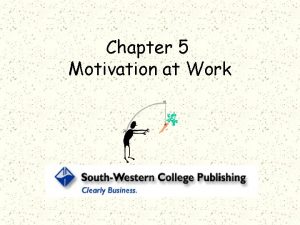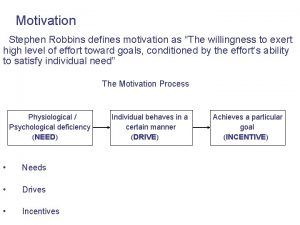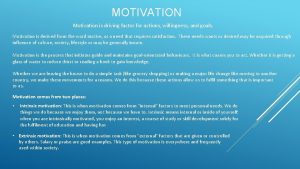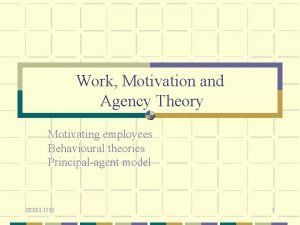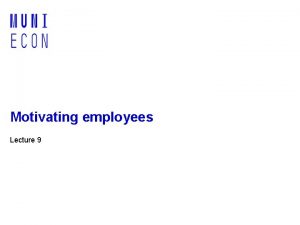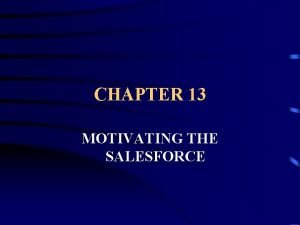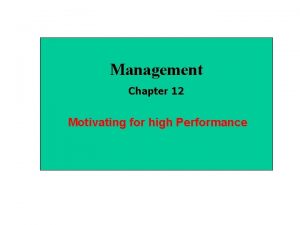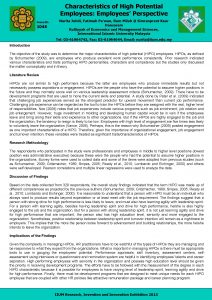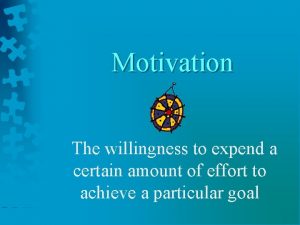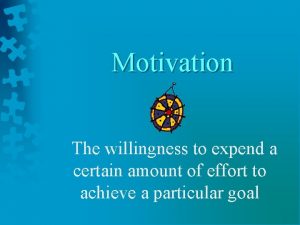Motivating Employees Motivation The willingness to exert high












































- Slides: 44

Motivating Employees

Motivation - The willingness to exert high levels of effort to reach organizational goals, conditioned by the effort’s ability to satisfy some individual need. Need - an internal state that makes certain outcomes appear attractive

Theories of Motivation

I. Maslow’s hierarchy of needs theory - there is a hierarchy of 5 human needs: physiological, safety, social, esteem, and self actualization.

1. Physiological needs: food, drink, sexual satisfaction, and other physical requirements.

2. Safety needs: security and protection from physical and emotional harm, as well as assurance that physical needs will continue to be met.

3. Social needs: affection, belongingness, acceptance, and friendship

4. Esteem needs: internal esteem factors such as self respect, autonomy, and achievement and external esteem factors such as status, recognition, and attention.

5. self actualization needs: a person’s need to become what he or she is capable of becoming.

II. Mc. Gregor’s theory X and Y theory X - the assumption that employees dislike work, are lazy, avoid responsibility, and must be coerced to perform.

Theory Y - the assumption that employees are creative, enjoy work, seek responsibility, and can exercise self-direction.

III. Herzberg’s motivationhygiene theory - intrinsic factors are related to job satisfaction and motivation, whereas extrinsic factors are associated with job dissatisfaction.

Motivators achievement recognition work itself responsibility advancement growth

Hygiene factors supervision company policy relationship with supervisor working conditions salary relationship with peers personal life relationship with subordinates status security

IV. Three-needs theory - says three needs (achievement, power, and affiliation)are major motives in work

Need for achievement - the drive to excel, to achieve in relation to a set of standards. And to strive to succeed

Need for power- the need to make others behave in a way that they would not have behaved otherwise.

Need for affiliation - the desire for friendly and close interpersonal relationships

V. Goal setting theory - the proposition that specific goals increase performance and that difficult goals, when accepted, result in higher performance than do easy goals

Self-efficacy - an individual’s belief that he or she is capable of performing a task.

VI. Reinforcement theory - theory that behavior is a function of its consequences.

Reinforcers - any consequence immediately following a response that increases the probability that the behavior will be repeated.

Designing Motivating Jobs

Job design - the way tasks are combined to form complete jobs.

Job scope - the number of different tasks required in a job and the frequency with which those tasks are repeated.

Job enlargement - the horizontal expansion of a job by increasing job scope.

Job enrichment - the vertical expansion of a job by adding planning and evaluating responsibilities.

Job depth - the degree of control employees have over their work.

Job characteristics model - a framework for analyzing and designing jobs. It identifies 5 primary job characteristics, and their impact on workplace outcomes. 1. Skill variety - the degree to which a job requires a variety of activities so that an employee can use a number of different skills and talents.

2. Task identity - the degree to which a job requires completion of a whole and identifiable piece of work 3. Task significance - the degree to which a job has a substantial impact on the lives or work of other people.

4. Autonomy - the degree to which a job provides substantial freedom, independence, and discretion to the individual in scheduling the work and determining the procedures to be used in carrying it out

5. Feedback - the degree to which carrying out work activities required by a job results in the individual’s obtaining direct and clear information about the effectiveness of his performance.

Equity theory - theory that an employee compares his job’s inputsoutcomes ration with that of relevant others and then corrects any inequity.

Referents - the persons, systems, or selves against which individuals compare themselves to assess equity.

Expectancy theory - theory that an individual tends to act in a certain way based on the expectation that the act will be followed by a given outcome and on the attractiveness of that outcome to the individual

A. expectancy or effort-performance linkage - the probability perceived by the individual that exerting a given amount of effort will lead to a certain level of performance.

B. instrumentality or performancereward linkage - the degree to which the individual believes that performing at a particular level is instrumental in attaining the desired outcome.

C. valence or attractiveness of reward - the importance that the individual places on the potential outcome or reward that can be achieved on the job.

Current Issues in Motivation compressed workweek - employees work longer hours per day but fewer days per week.

Flexible work hours(flextime) employees are required to work a certain number of hours per week but are free, within limits, to vary the hours of work.

Job sharing - the practice of having two or more people split a full-time job.

Telecommuting - a job approach in which employees work at home and are linked to the workplace by computer and modem.

Pay-for-performance programs compensation plans that pay employees on the basis of some performance measure.

Open-book management - a motivational approach in which an organization’s financial statements are shared with all employees.
 The willingness to exert high levels of effort
The willingness to exert high levels of effort Herzberg’s two-factor theory
Herzberg’s two-factor theory Motivating and satisfying employees and teams
Motivating and satisfying employees and teams Motivating employees without money
Motivating employees without money Motivating and satisfying employees and teams
Motivating and satisfying employees and teams Chapter 10 motivating and satisfying employees and teams
Chapter 10 motivating and satisfying employees and teams Motivating and satisfying employees and teams
Motivating and satisfying employees and teams Norm althouse
Norm althouse Chapter 10 motivating employees
Chapter 10 motivating employees Chapter 10 motivating employees
Chapter 10 motivating employees Motivating and satisfying employees and teams
Motivating and satisfying employees and teams Anglo american model of corporate governance
Anglo american model of corporate governance Fourethics
Fourethics Willingness to supply
Willingness to supply Language
Language Thank you to cooperating teacher
Thank you to cooperating teacher Crisis survival kit dbt
Crisis survival kit dbt Willingness to pay
Willingness to pay High potential employees criteria
High potential employees criteria Retention of high potential employees
Retention of high potential employees Gas pressure
Gas pressure Explain how currents and magnets exert forces on each other
Explain how currents and magnets exert forces on each other Do gases exert pressure on whatever surrounds them
Do gases exert pressure on whatever surrounds them The force you exert on a machine
The force you exert on a machine Difference between force and torque
Difference between force and torque What is the upward force that fluids exert on all matter
What is the upward force that fluids exert on all matter To exert energy
To exert energy A boxer cannot exert much force
A boxer cannot exert much force Congress is most likely to exert oversight
Congress is most likely to exert oversight The ability of the muscles to repeatedly exert themselves
The ability of the muscles to repeatedly exert themselves Motivating parallelism
Motivating parallelism Motivating students to learn english
Motivating students to learn english Designing motivating jobs adalah
Designing motivating jobs adalah Motivating operations examples
Motivating operations examples Three-term contingency example
Three-term contingency example Motivating operations definition
Motivating operations definition Sales force motivation theories
Sales force motivation theories Leadership is the art of motivating a group
Leadership is the art of motivating a group Channel motivation
Channel motivation Staffing and directing
Staffing and directing Motivating software engineers
Motivating software engineers Introduction to parallel computing ananth grama ppt
Introduction to parallel computing ananth grama ppt Samuel de champlain motivation
Samuel de champlain motivation Motivating people for total quality
Motivating people for total quality Sales force motivation
Sales force motivation




